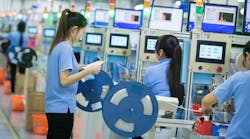Laird Performance Materials, a global company that makes protective components for high-tech products, has four plants and 3,400 employees near the southern coast of China. On January 21, employees were getting ready for their New Year’s trips back home when the fast-spreading coronavirus known as COVID-19 was emerging as a crisis, having already sickened hundreds of people in the Hubei province of China.
Laird’s plants were not in the epicenter of the virus, but they were in outlying areas that would see a significant number of infections. Adding a layer of complexity, many employees had traveled to Hubei to visit family over to celebrate the New Year.
Laird took swift action, appointing Sheetoh Waichong, vice president of Laird’s Asia operations, as head of the company’s COVID-19 task force. Waichong had plenty of experience running plants around the world at Jabil, but can anything really prepare you for a global pandemic?
While the plant was shutdown two weeks for China’s New Year, Waichong’s task force rallied, crafting a plan that would have the plants reopening on February 4 with 44% of the workforce, and 98% of the workforce back at their jobs by February 28. It has been a success: None of the workers as of this writing have become infected with the coronavirus, and the fact that customer orders are on time and orders themselves are actually higher than they were before the virus is a testament to the task force’s planning. (With the new orders ramping things up, the workforce in the factories now actually is above 100% of what it was pre-virus.)
With the China plants stabilized, Waichong is now leading Laird’s coronavirus response in North America and Europe. Fresh off a six-hour wait in customs after arriving in China from Singapore on Wednesday, he talked with IndustryWeek about what has made Laird’s coronavirus planning work.
1. We came up with a plan and got masks right away
Waichong was appointed head of the Asia coronavirus response on January 21. By January 22, he had formed a coronavirus task force in each of the four factories, consisting of team members of from EHS, human resources, communications and operations, and representatives from the customers too. Task force members had a daily conference with Waichong, discussing every single detail in their plan, from masks to cleaning to sterilization to workstation separation to transportation.
An early priority was securing masks—the surgical mask and the N95 mask. Waichong bought six months’ worth of mask stock before the Chinese New Year started on January 25. On January 21, “there was still plenty of stock,” he says. A week later, the lead time was four to 10 weeks.
Masks were mailed to employees at their homes during the New Year break, so they could use them while they were away and distribute to members of their household—as masks were no longer available in the markets.
2. We paid employees even if they could not show up for work.
Many employees had gone home for break to their extended families three, four, five hours away. Those visiting the Hubei province could not leave to come back to work by February 4.
“We were quite sure that they would be very worried, so we actually started communication with them [during the New Year] to assure that even if they cannot come to work, their salary would still be paid,” says Waichong. “So we put the most number one concern in their mind to rest.”
During the break, Waichong and his team communicated with employees via texting. A psychologist worked with the task force to help with messaging, and they tried to address questions that, when answered, would “alleviate anxiety.”
3. We communicated quickly with customers and suppliers.
By January 23, the task force was sending a message to Laird’s customers, saying in effect: “I know you are worried about our delivery from the four factories in China. But let me tell you, we are working on our plan and we will come back to you with this plan very, very quickly.”
The task force communicated with suppliers as well, so everyone was aligned on what they were doing. “And in fact, I am happy to say that even with this virus situation happening—all of our China factories’ orders, none of them received any cancellation,” says Waichong. “In fact, we received more orders over the last four weeks [than in the weeks before the virus],” in part because they received a lot of media attention in China around their quick bounceback.
4. We secured 500 hotel rooms to quarantine employees coming back to the factory from other cities. The company paid for their hotel, and employees were paid their salaries during the two-week quarantine.
5. To prevent infection, we staggered start times and breaks – some started at 8 a.m., some at 8:10, some at 8:50, “so that there’s no big group at our entrance,” says Waichong. They also staggered lunch breaks over two hours, and moved some of the canteen tables outside so employees could sit a safe distance apart.
6. We disinfect plants twice a day.
That last week in January, the task force secured sterilization chemicals and hired professionals to do the cleaning in the canteen, in the office area, in the toilets and the factory area. They clean twice a day. “That is good enough to kill any virus in the factory,” says Waichong.
7. We take workers’ temperature twice a day. “They don’t stand in line. We have people go around taking their temperature. Some will stand at the gate taking their temperature as employees slowly come in. And in the canteen area.” And also in the entrance to the production floor.
If a person who is not feverish at the start of work has a temperature four or five hours later above 37.1 C, they’re considered to have a fever and sent to the hospital for further testing. Anyone working near that person for more than 30 minutes at ta ime will also be tested and quarantined in the hotel or at home for two weeks if the test is negative. People who test positive for the virus in China are quarantined in a government hospital, not at home.
Waichong admits the temperature-taking will be more of a challenge at Laird’s plants in the U.S. and Europe, where people have more personal freedom and where he’s now leading virus prevention efforts. “It’s more on a voluntary basis,” he says. “We can’t go around and say, ‘Hey, I’ve got to take your temperature; you must let me take it,” he says.
He advises mentioning early on to employees that, for the safety of themselves and their fellow employees, it’s best to have their temperature taken twice a day.
8. We put up partitions separating workers by at least 1.5 meters each.
The partitions started going up that last week in January. At first they were makeshift—cut-up cardboard boxes—but they have slowly been replaced with plastic transparent material so production workeres can see what’s happening on the line and communicate better with their immediate co-workers.
9. We consulted with the government. They were required to do this, of course, needing Chinese government approval to resume operations. The government sent a hospital team to audit the task force’s program and not only found it “more than acceptable” but scored the Laird plants in the top 10% of factories in China to resume operation.
In the U.S. and Europe, Waichong estimates Laird’s are 80 to 90% ready for virus prevention. “We were able to apply the experience of the China factories,” he says. This week, he was reviewing the plan with the Czech factory, “and I’m very happy they have all the things covered.”
Another cultural difference is that in China, “We can ask people, please update your whereabouts every day on social media. We use WeChat, right, and everybody will say, ‘Okay, okay!’ and update every day in WeChat.” In Europe and North America, the communication is different: “It’s important to know if you have been in a highly infected area, that self-reporting is for the safety of everybody.”
In Europe, where unions are strong, “we have to talk about mask-wearing with the union, like: “Hey we recommend masks to be worn by our employees—what do you think?”
“As every day the virus situation changes, I think people’s awareness will change as well,” says Waichong. “So whatever we are doing for the employee, we want to make sure that everybody’s comfortable with our action.”
At the Czech plant, the site general manager has lined up backup production at other Laird plants for his factory’s major products just in case the government locks up the factory. “Likewise, by next week all our North American factories will have contingency plans to have their production outside North America by next week,” says Waichong.
One thing that has made this whole process easier is that Laird already had a culture conducive to crafting and implementing detailed plans, says Waichong.
“This is a high-tech company and I believe this also helped us to become very, very detailed in whatever we are doing—when we are solving a problem or when we are thinking about new technology or when we are planning for a new product in the R&D meeting,” he says. In meetings, “we find the root cause very, very accurately, and that helped us find problems [with the coronavirus] ahead of the others. In fact, we also used FMEA [Failure Mode and Effects Analysis] concepts like failure mode analytics to actually predict what could go wrong. That helped us identify many, many potential problems that could come our way.”
Main photo: The Laird Performance Materials plant in Shenzhen, China.





